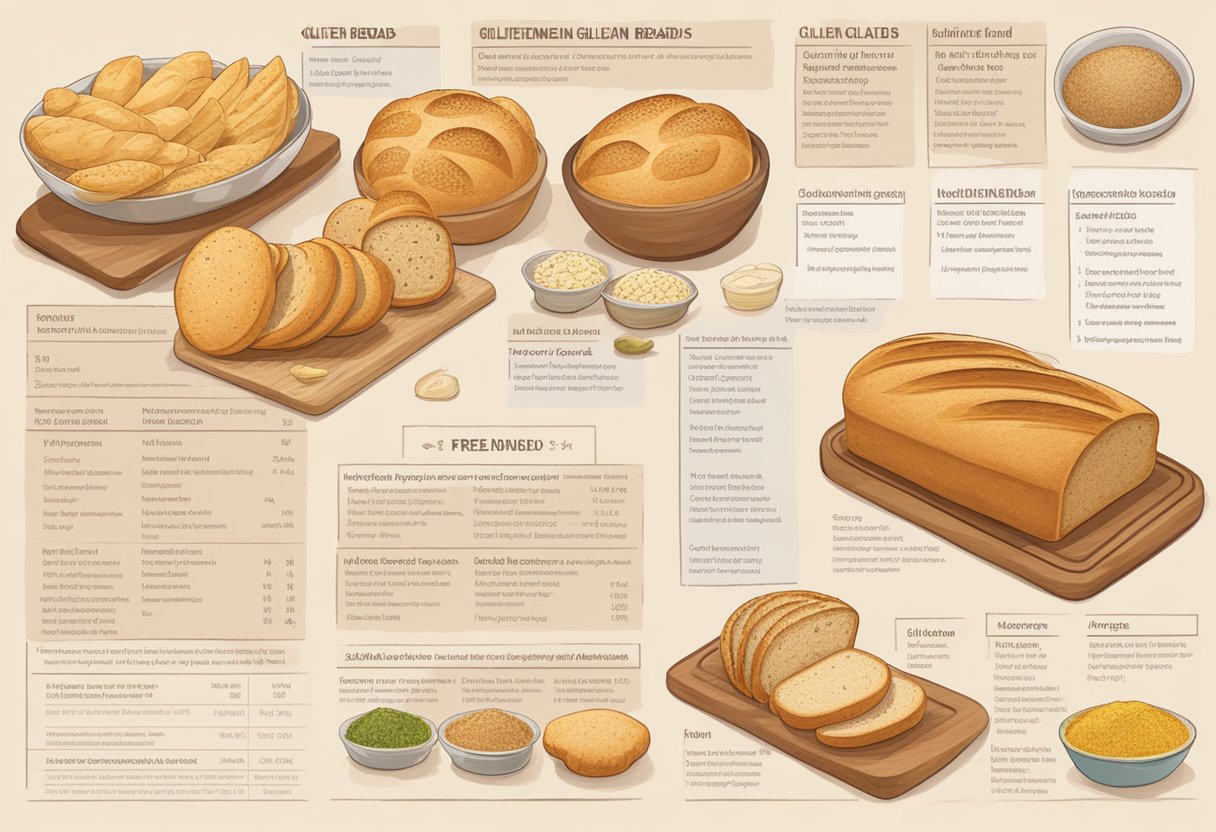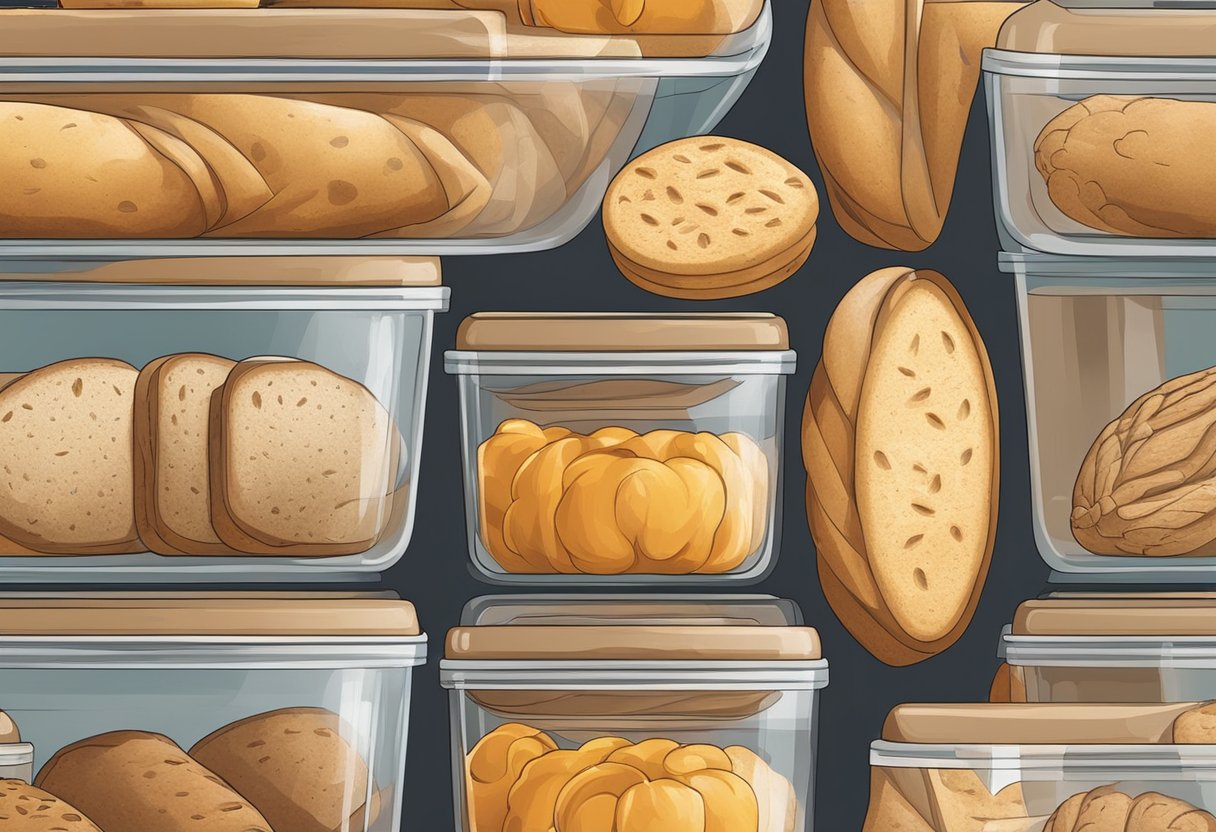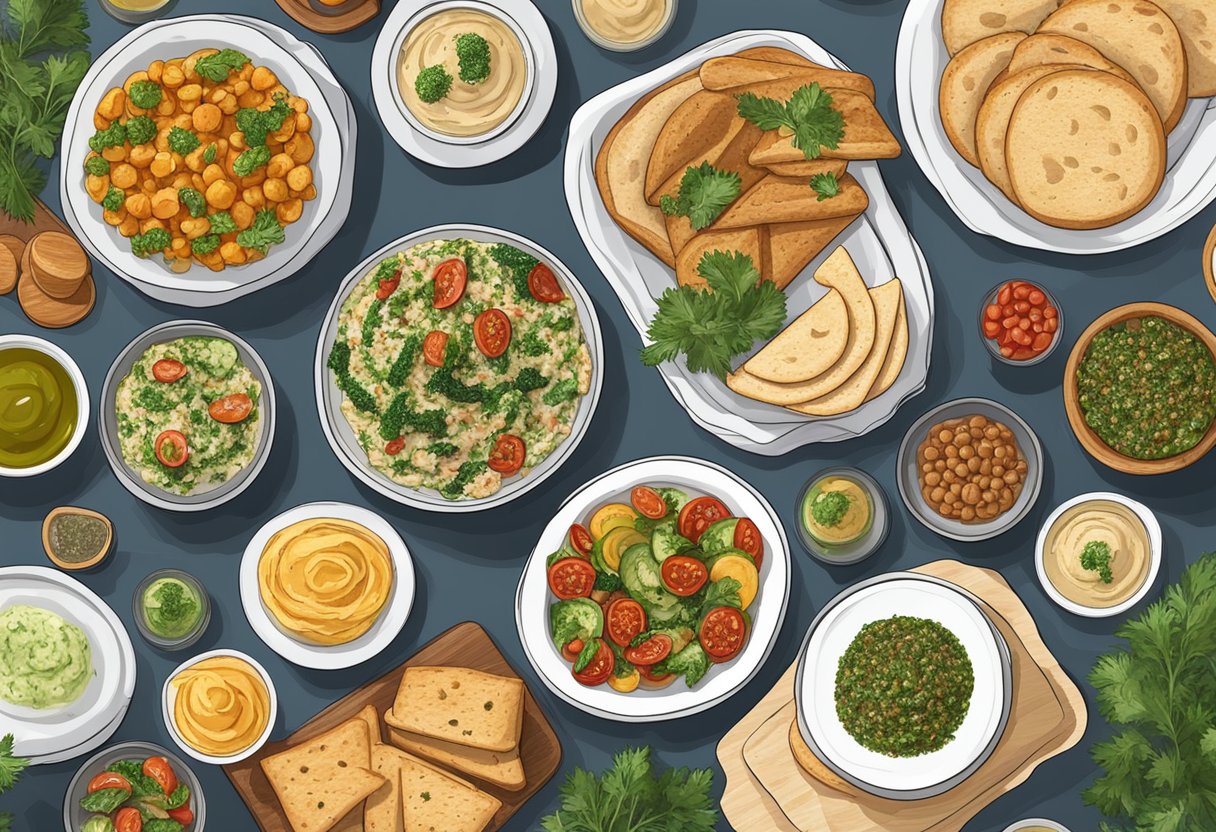Gluten-free Mediterranean breads offer a delectable option for those who follow a gluten-free diet or anyone looking to enjoy the health benefits of Mediterranean fare without the gluten. Breads are a staple in Mediterranean cuisine, known for their rich flavors, varied textures, and wholesome ingredients. Adapting these bread recipes to be gluten-free allows even more individuals to indulge in the culinary delights of the Mediterranean while maintaining their dietary needs.

Creating gluten-free breads requires substituting traditional wheat flour with alternatives such as almond flour, rice flour, or other gluten-free blends that still deliver a satisfying taste and texture. The process also involves the careful selection of ingredients that align with the nutritional tenets of the Mediterranean diet, such as incorporating healthy fats and a variety of seeds and nuts. Perfecting gluten-free Mediterranean breads involves mastering the art of blending these ingredients to create loaves that satisfy the palate just as well as their gluten-containing counterparts.
Key Takeaways
- Gluten-free Mediterranean breads combine traditional flavors with alternative flours.
- Crafting these breads involves selecting ingredients that cater to both taste and nutrition.
- Mastery of blending and baking techniques is key to achieving optimal gluten-free bread quality.
Table of Contents
Understanding Gluten-Free Baking

When venturing into gluten-free baking, comprehending the properties of gluten-free flours and the role of each ingredient is crucial for successful Mediterranean bread recipes.
The Basics of Gluten-Free Flours
Gluten-free baking relies on a harmonious blend of gluten-free flours to replicate the texture and structure traditionally provided by gluten. Key flours often include rice flour, known for its light texture; oat flour, which adds a pleasant taste and crumbly texture; potato starch, for moisture retention; and sorghum flour, praised for its nutritional profile and mild flavor. These flours do not contain gluten, unlike wheat, barley, or rye, making them suitable for those who follow a gluten-free or grain-free diet.
Role of Ingredients in Gluten-Free Bread
In gluten-free Mediterranean breads, each ingredient has a specific function:
- Yeast: A staple that causes the dough to rise by fermenting sugars into carbon dioxide.
- Sugar: Feeds the yeast to aid in leavening and can enhance the bread’s flavor.
- Eggs: Provide structure and moisture, also binding the ingredients together.
- Olive oil: Contributes to the tender crumb and classic Mediterranean flavor.
- Salt: Balances the flavors and controls yeast fermentation.
- Nuts and seeds: Add textural variation and nutritional value.
Combining dry ingredients like flours, yeast, and salt with wet ingredients such as water, eggs, and olive oil, leads to a cohesive dough suitable for a variety of bread styles. The baker must meticulously measure and mix these components to ensure a well-balanced and palatable result.
Creating the Perfect Dough

Creating the perfect dough for gluten-free Mediterranean breads involves mastering the subtle art of mixing, kneading, and proofing, adjusting traditional methods to accommodate gluten-free requirements.
Mixing and Kneading Techniques
For gluten-free Mediterranean bread, the mixing process begins in a mixing bowl with carefully measured ingredients to ensure balance in flavor and texture. One must combine gluten-free flour with active dry yeast that’s been activated in lukewarm water to help the bread rise. Mix the ingredients until they form a cohesive dough, being mindful that gluten-free dough doesn’t require as much kneading. Some recipes even suggest a no kneading approach, where the ingredients are simply mixed thoroughly and allowed to rest.
- Start by activating the yeast in lukewarm water.
- Slowly add in the gluten-free flour while mixing.
- Mix until the dough comes together without overworking it.
Proofing and Rising for Gluten-Free Breads
Proofing and allowing the dough to rise is crucial, yet it can be challenging with gluten-free breads due to the lack of gluten’s elasticity. For successful proofing, place the dough in a warm, draft-free area after it has risen slightly during the initial rest. The dough should be covered with a damp cloth to lock in moisture and prevent drying out. This stage is when the bread develops its flavor and structure, so patience is key.
- Cover the dough with a damp cloth and place it in a warm area.
- Allow sufficient time for the dough to rise and double in size.
Through attentive mixing and proofing, gluten-free Mediterranean bread can achieve the desired texture and taste that one expects from a well-crafted loaf.
Popular Gluten-Free Mediterranean Bread Recipes
Mediterranean bread recipes are a delightful way to enjoy the flavors of the region without gluten. They combine traditional herbs such as oregano, rosemary, and thyme with the distinct tastes of olive oil, garlic, and sea salt to create truly unique and flavorful breads.
Mediterranean Flatbread
Gluten-free Mediterranean flatbread typically includes a blend of gluten-free flours, providing a sturdy yet flexible base for a variety of toppings. Key ingredients like olive oil and sea salt create a rich, savory flavor, while herbs like oregano and rosemary add an aromatic touch. What makes flatbread so universally loved is its versatility, serving as the perfect canvass for creative culinary expressions. For a step-by-step guide on creating this staple, readers may wish to explore a well-crafted gluten-free Mediterranean flatbread recipe.
Gluten-Free Olive Bread
This bread celebrates the olive not just as a garnish but as a star player. Incorporating whole olives into the dough gives this gluten-free olive bread a moist texture and bursts of briny flavor with each bite. The addition of garlic and rosemary enhances the Mediterranean profile, reminding the diners of coastal European landscapes. Gluten-free olive bread pairs wonderfully with a crisp salad or a bowl of soup, making it a versatile choice for any meal.
Gluten-Free Pita Bread
Gluten-free pita bread is lighter than other bread varieties and often comes with a handy pocket that can be stuffed with fresh veggies, grilled meats, or cheeses. Crafting these gluten-free pockets does require some skill, as achieving the right consistency and the integral pocket involves precise moisture and temperature control. The result is a soft, chewy bread that can be as adaptable as it is delicious. Those looking for a reliable gluten-free option can find detailed instructions through this easy flatbread recipe.
Nutritional Profile of Gluten-Free Breads

Gluten-free breads can vary widely in their nutritional content, impacting individuals who adhere to a Mediterranean diet. These breads often contain differing amounts of calories, macronutrients, and fibers, with their health benefits influenced by the specific whole ingredients used.
Counting Calories and Macros
Gluten-free breads generally possess a calorie count similar to that of traditional breads; however, one particular slice typically delivers approximately 83 calories. The macronutrient profile signals 1.5g of protein and 1.5g of dietary fiber, which is notably lower than many wheat-based loaves. The fat content is often about 2.2g per slice, potentially providing a mix of healthy fats depending on the ingredients used.
Benefits of Whole Ingredients
Incorporating organic, whole ingredients into gluten-free breads can enhance their health profile, bringing them closer to the nutrient-rich ethos of the Mediterranean diet. Fresh, whole ingredients can boost the protein and fiber content, while also providing essential vitamins and minerals. Making use of whole seeds, nuts, and ancient grains enhances the overall nutritional value, contributing to a healthier option for those requiring a gluten-free diet.
Advanced Baking Techniques

Mastering the art of gluten-free Mediterranean bread baking requires an understanding of how to manipulate ingredients and baking conditions to produce a perfect crust and crumb.
Creating a Crunchy Crust
To achieve a crunchy crust on gluten-free Mediterranean bread, bakers often utilize a preheated cast iron skillet or baking stone. The intense and even heat these deliver help to mimic the effects of a professional oven. Immediately before placing the dough into the oven, spraying water inside can create a burst of steam which contributes to crust development. Additionally, a light dusting of baking powder on the surface can promote browning, giving the crust that desirable golden brown finish.
Achieving a Tender Crumb
For a tender, fluffy crumb within gluten-free bread, the dough should be handled with care. After mixing, the dough requires a floured surface for shaping, which can be done gently to maintain the air pockets that contribute to lightness. The proofing process is critical – the dough must rise until it’s just right, which can vary depending on recipe specifics. Ultimately, once baked, placing the bread on a wire rack allows air to circulate and prevents the bottom from becoming soggy, preserving the bread’s tender interior.
Storing and Preserving Gluten-Free Breads

When incorporating gluten-free bread into a Mediterranean diet, it is essential to understand proper storage and preservation techniques to maintain freshness and flavor. Correctly storing bread can significantly extend its shelf life and ensure that it remains a delightful part of meals.
Freshness and Shelf Life
Gluten-free breads, often made with a variety of grains and seeds integral to a Mediterranean diet, tend to have a shorter shelf life than their gluten-containing counterparts. They should preferably be stored at room temperature for two to three days in a dry, cool place. For optimal freshness, one should slice the bread only before consumption and keep it in a bread box or wrapped in cling film to prevent exposure to air, which can dry it out quickly.
Freezing Instructions
To preserve gluten-free bread for longer periods, freezing is the most effective method. The bread should be allowed to cool completely after baking to avoid condensation, which can lead to sogginess. Once cool, wrap the bread tightly in freezer-friendly wraps, like aluminum foil or plastic freezer bags, ensuring all air is pressed out. Bread can be pre-sliced for convenience, allowing for single servings to be defrosted as needed without having to thaw the entire loaf. Stored properly, gluten-free bread can be frozen for up to three months without compromising quality.
Pairing Breads with Mediterranean Dishes

Pairing the right gluten-free bread with Mediterranean dishes enhances the flavor and complements the meal’s profile. Whether used as a key component or as an accompaniment, selecting the appropriate bread can transform the entire dining experience.
Bread as a Component in Salads and Starters
Gluten-free breads complete a Mediterranean salad or starter by adding both texture and substance. For instance, crumbled gluten-free olive bread from Only Gluten Free Recipes can elevate a simple green salad with its rich, savory olives and hearty crust. Speaking of starters, gluten-free rolls can serve as a base for bruschetta, topped with tomato, basil, and a drizzle of olive oil, making it a perfect gluten-free appetizer.
Gluten-Free Breads as a Side Dish
As a side dish, gluten-free bread is versatile and can accompany a wide array of Mediterranean courses. An aromatic gluten-free bread seasoned with dried oregano serves as an excellent accompaniment to a course of falafel, creating a balanced and satisfying meal. In the realm of pizza, a crispy gluten-free crust acts as a canvas for various toppings, allowing one to enjoy a complete meal that adheres to a gluten-free diet without compromising on flavor or satisfaction.
Adapting Recipes to Dietary Restrictions

Adapting traditional Mediterranean bread recipes to accommodate dietary restrictions ensures everyone can enjoy these staples. The focus here is on creating vegan-friendly options and addressing common allergens such as wheat, eggs, and nuts in gluten-free baking.
Vegan-Friendly Modifications
Mediterranean breads often contain eggs and cheese, which are not suitable for a vegan diet. To replace eggs, one can use flaxseeds or chia seeds mixed with water. Each tablespoon of flaxseed or chia seed, combined with three tablespoons of water, can substitute one egg. For cheese, nutritional yeast or vegan cheese alternatives can be used.
Egg Substitutes:
- 1 tbsp Flaxseed + 3 tbsp Water = 1 Egg
- 1 tbsp Chia Seeds + 3 tbsp Water = 1 Egg
Cheese Substitutes:
- Nutritional yeast
- Vegan cheese products
Alternative Ingredients for Common Allergies
Gluten-free Mediterranean breads typically avoid wheat. Instead of wheat flour, one can use a blend of gluten-free flours such as rice flour, tapioca flour, and almond flour. Oats can be included if they are certified gluten-free to avoid avenin, a protein similar to gluten. Those avoiding nuts can use seed flours, like sunflower or pumpkin seed flour, as an alternative.
- Flour Substitutes:
- Rice flour
- Tapioca flour
- Certified gluten-free oats
- Almond flour (avoid if allergic to nuts)
- Seed flours (alternatives for nut allergies)
Remember to read ingredient labels carefully to ensure that all components are indeed gluten-free and adhere to other dietary restrictions.
Tips for Successful Gluten-Free Bread Making

Creating gluten-free Mediterranean breads that are both delicious and structurally sound requires precision and understanding of gluten-free ingredients. A solid grasp of techniques and troubleshooting can lead to exceptional homemade, savory breads.
Troubleshooting Common Issues
-
Proportioning Ingredients: One common issue bakers face is the bread’s texture. Achieving the right balance of flours is crucial. Gluten-free flours must be painstakingly measured; a kitchen scale is more accurate than measuring cups. Compressing the flour by scooping directly from the bag with a measuring cup can lead to heavy, dense bread. Instead, bakers should use a spoon to fill their measuring cup and level it with a knife for more consistent results. For instance, when creating thin and crisp flatbreads, precise measurements are pivotal to avoid a brittle outcome.
-
Bread Structure and Rise: Gluten-free breads often struggle with rising properly. One secret is using a high-protein flour blend which lends strength to the structure, crucial for savory loaves and rolls. Incorporating eggs into the mix can further help, as they contribute to the bread’s stability and rise. A large bowl gives the dough enough space to expand during the rising process; this space should be warm and free from drafts.
Time-Saving Strategies for Busy Cooks
-
Streamlining Prep: For those with limited time, organization maximizes efficiency. By arranging all ingredients in a large mixing bowl beforehand, the baker ensures they are ready to begin without pause. Using proven recipes saves time spent on experimentation and potential mistakes.
-
Accelerating Cook Time: An established Mediterranean staple such as pita bread requires a high-heat oven to puff up quickly. By preheating the oven during the final rise, one can slash total time spent in the kitchen. Additionally, preparing several batches at once can make the most of the oven’s heat and the cook’s time.
In the end, whether it’s a focaccia or ciabatta, successful gluten-free Mediterranean bread making revolves around accurate measurements, the right ingredients, and savvy time management.
Frequently Asked Questions

Navigating the landscape of gluten-free Mediterranean breads can be challenging. Below, key questions are addressed to help individuals find delicious alternatives and maintain their dietary needs within the realm of Mediterranean cuisine.
What are some delicious gluten-free alternatives to traditional Mediterranean breads?
Gluten-free alternatives abound, including options like almond flour flatbreads and coconut flour tortillas. These substitutes provide a satisfying texture and are versatile for various Mediterranean dishes.
How can I find the best-rated gluten-free pita bread available for purchase?
One can find the best-rated gluten-free pita by researching online reviews and food blogs that specialize in gluten-free products. Additionally, health food stores often carry high-quality gluten-free bread options.
Which Mediterranean bread recipes can be adapted to be gluten-free without compromising taste?
Classic recipes for focaccia or ciabatta can be made gluten-free with substitutions such as rice flour or gluten-free all-purpose flour blends, ensuring a taste that is comparable to traditional versions.
Is it possible to enjoy gluten-free bread while adhering to a Mediterranean diet?
Yes, one can enjoy gluten-free bread within the Mediterranean diet. Options such as buckwheat, oat, or cornbread align with the diet’s emphasis on whole foods and natural ingredients.
Are there any Mediterranean breads that are naturally free of gluten?
Certain Mediterranean breads, like those made from chickpea flour or millet, are inherently gluten-free and offer a wholesome alternative to wheat-based breads.
What should I look for in gluten-free bread if I have a gluten intolerance?
Those with gluten intolerance should look for breads that are certified gluten-free and made with whole food ingredients to avoid cross-contamination and ensure that the product meets dietary restrictions.



